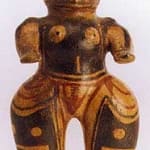Terracotta Polychrome Standing Figure, 500 CE - 1000 CE
Terracotta
5 x 10
PF.3863
During the early part of Period V (ca.500 -800 A.D.) polychrome male and female figures were made with their bodies completely covered with designs. The majority of these probably had...
During the early part of Period V (ca.500 -800 A.D.) polychrome male and female figures were made with their bodies completely covered with designs. The majority of these probably had a religious significance related to fertility. This remarkable figure may well fall into the fertility/fecundity genre, with its wide hips, solid legs and prominently marked breasts. Large black areas reaching nearly to the hips with four white circles on each divided by a broad white line distinguish the legs. Red curved lines delineate the upper portion of the legs, and are connected to the groin that is covered by a loincloth painted red. The chest area and shoulders are also in black to better accentuate the breasts. Most striking is the face covered in short lines meeting at acute angles divided by black and red horizontal and vertical lines. This may symbolize actual tattooing or scarification of priests connected with fertility rites, and in fact resembles the face painting of certain Amazonian people. This figure makes a bold statement, a direct plea to unknown forces and to our modern sensibilities that respond immediately to its directness and expressive beauty.



